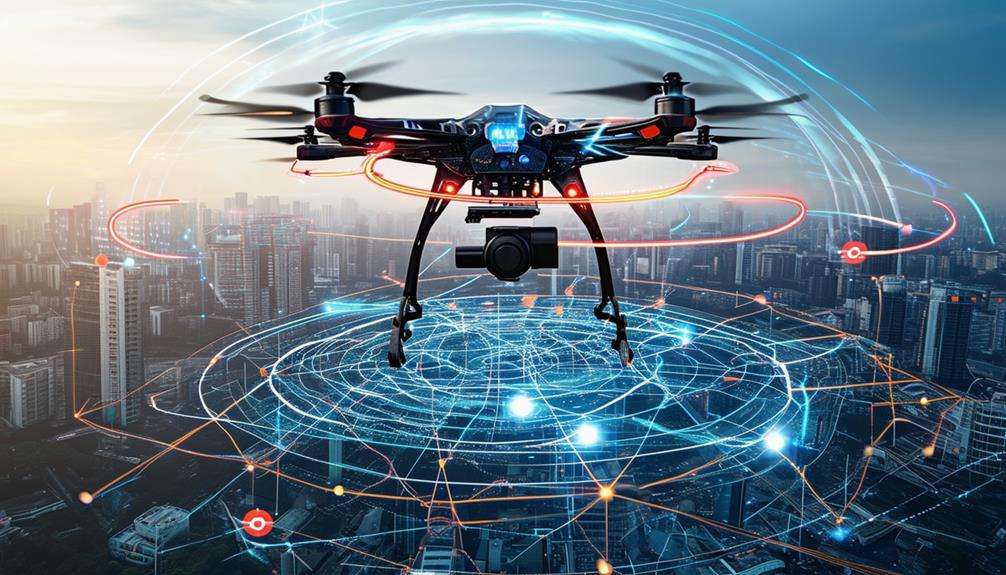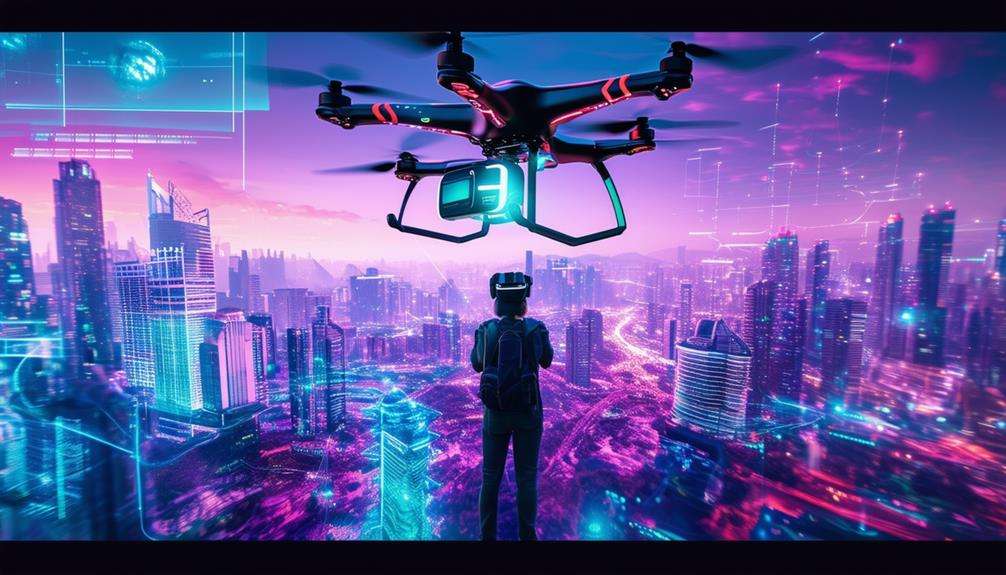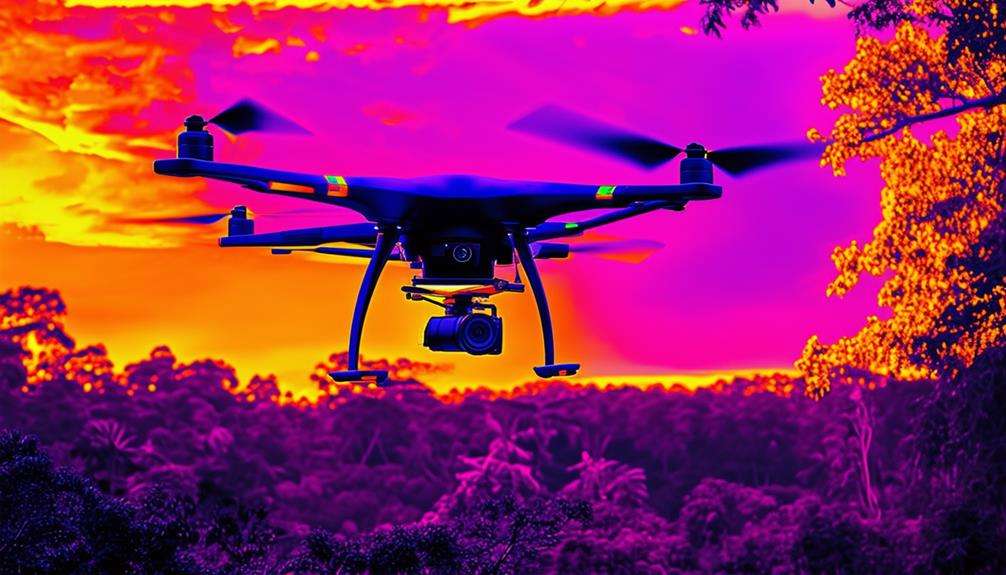The Future of UAV Swarming Technology: Coordinated Drones in Action
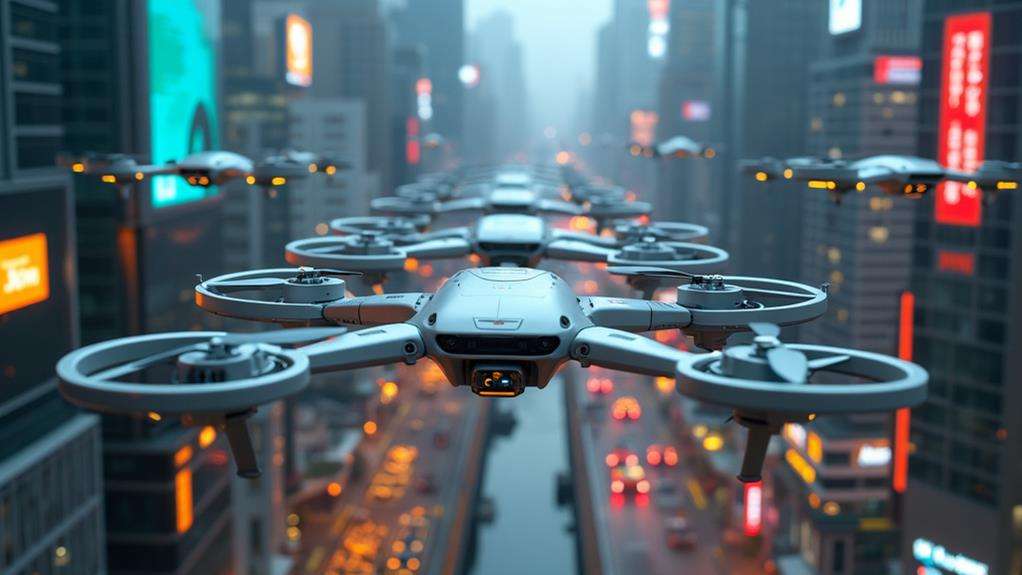
Imagine a world where drone swarms execute complex tasks with seamless coordination, transforming military operations and disaster response. Driven by advancements in AI and machine learning, UAV swarming technology promises just that. These autonomous systems adapt to ever-changing environments, presenting both opportunities and challenges. Consider the implications for urban mobility and surveillance, but be mindful of significant hurdles such as communication reliability and ethical concerns. So, what's next for this cutting-edge technology?
Overview of Drone Swarms
When it comes to UAV swarming technology, drone swarms represent a groundbreaking advancement in military operations. These coordinated groups of drones significantly enhance capabilities in surveillance, reconnaissance, and combat. By leveraging swarm intelligence, these UAVs operate in a decentralized, self-organized manner, much like bees or ants, allowing them to perform complex tasks collaboratively.
In military applications, the integration of AI plays a crucial role. AI integration enables these drones to make autonomous decisions, improving their efficiency and effectiveness on the battlefield. Advanced communication systems allow for seamless collaboration among the drones, ensuring they can adapt to dynamic environments and mission requirements.
Drone swarms have shown remarkable potential in increasing the lethality of attacks while reducing drone loss rates by up to 50%. This strategic advantage makes them invaluable in modern warfare. Additionally, sophisticated sensor technology enhances their surveillance capabilities, providing real-time intelligence that is vital for tactical planning and execution.
As the market for drone swarm technology is projected to reach $447.2 million by 2030, driven by a CAGR of 40.47%, it's clear that their role in intelligence gathering and military advancements will only continue to grow.
Technological Innovations
Explore how AI-driven swarm coordination and advanced sensor integration are revolutionizing UAV swarming technology. AI enables drones to make autonomous decisions and optimize formations, enhancing efficiency. Meanwhile, cutting-edge sensors improve surveillance and reconnaissance capabilities, making UAVs invaluable for both military and civilian applications.
AI-Driven Swarm Coordination
AI-driven swarm coordination, inspired by nature's systems, utilizes algorithms that mimic the behaviors of bees and birds to revolutionize drone operations. Leveraging swarm intelligence, this technology enhances the decision-making and efficiency of UAV swarms. With advanced machine learning techniques, drones can autonomously adjust their formations and tactics in real-time, responding dynamically to environmental data and mission parameters.
Swarm coordination relies on principles of separation, alignment, and cohesion, ensuring effective communication and collaboration among drones. This enables coordinated behavior even in complex environments with limited communication. By employing consensus algorithms, swarms can quickly synchronize their actions, demonstrating remarkable adaptability and efficiency.
Advanced Sensor Integration
Advanced sensor integration elevates UAV swarming technology by enhancing its imaging and detection capabilities, making it highly effective for surveillance and reconnaissance. By incorporating sensors such as LiDAR, infrared cameras, and multi-spectral imaging, drone swarms achieve superior situational awareness, enabling precise target identification in complex environments.
Real-time data captured by these sensors is processed with sophisticated AI algorithms, facilitating immediate decision-making and adaptive strategies. This seamless integration ensures that drone swarms can respond swiftly and efficiently to evolving scenarios.
Moreover, advanced sensors strengthen communication systems among drones, ensuring secure and efficient data exchange during coordinated operations. This connectivity is crucial for maintaining the swarm's cohesion and operational effectiveness.
Key benefits of advanced sensor integration in UAV swarming technology include:
- Enhanced imaging: High-resolution cameras and sensors deliver detailed visuals.
- Precise detection: LiDAR and infrared sensors enhance target identification.
- Situational awareness: Multi-spectral imaging aids in understanding complex environments.
- Immediate decision-making: AI algorithms process real-time data for rapid responses.
- Secure communication: Robust systems ensure data integrity and coordination.
The continuous innovation in sensor technology drives the operational effectiveness of drone swarms, capturing significant market interest and military investment.
Military Applications
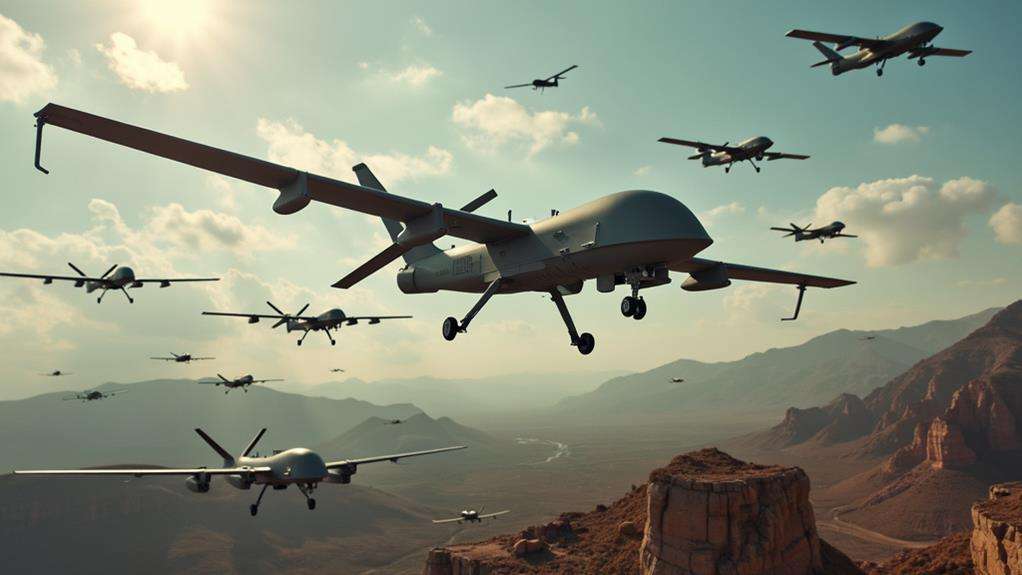
When considering military applications, drone swarms serve as tactical force multipliers, significantly enhancing operational lethality and effectiveness. They provide real-time battlefield management through advanced AI, enabling autonomous decision-making and task allocation. By integrating these capabilities, military forces can execute complex missions more efficiently and cost-effectively.
Tactical Force Multipliers
Military drone swarms are game-changers, revolutionizing tactical operations as force multipliers. These swarms of unmanned aerial vehicles (UAVs) significantly enhance the lethality and efficiency of attacks, increasing effectiveness by up to 50% and reducing drone loss by the same margin. Utilizing swarm intelligence and AI-powered systems, these drones autonomously execute complex missions without centralized control, providing a critical tactical advantage in modern warfare.
On the battlefield, imagine:
- AI-driven UAVs working in unison, forming a network of intelligence and firepower.
- Real-time data sharing, delivering instant situational awareness and better decision-making.
- Cost-effective deployment, enabling the simultaneous use of numerous drones, supplanting expensive traditional assets.
- Partnerships with tech innovators like Maris-Tech and Shield AI, advancing drone capabilities.
- Enhanced versatility, with drones adapting roles between surveillance, reconnaissance, and combat.
These tactical force multipliers are not just about overwhelming the enemy with numbers but also about operational efficiency. Integrating advanced technologies ensures military operations are precise and adaptable, making drone swarms indispensable in contemporary warfare.
Real-Time Battlefield Management
Real-time battlefield management utilizes UAV swarming technology to revolutionize military operations. By deploying multiple drones simultaneously, real-time data collection is enhanced, significantly improving situational awareness and enabling commanders to make swift, informed decisions that boost operational efficiency.
Swarm intelligence elevates battlefield management by allowing drones to autonomously adapt to evolving scenarios. This decentralized approach ensures faster and more effective responses in dynamic combat situations. The integration of advanced AI capabilities is transformative, enabling drones to process real-time data, predict enemy movements, and adjust tactics on the fly, thereby increasing mission success rates by up to 50%.
Additionally, military drone swarms excel in coordinated surveillance and reconnaissance missions, offering comprehensive battlefield coverage. This supports precise artillery targeting and reduces risks to personnel. The collaborative capabilities of these swarms facilitate the execution of complex tasks simultaneously, including search and rescue operations, logistics support, and tactical strikes. This maximizes resource utilization and operational effectiveness, making real-time battlefield management more efficient and responsive. With UAV swarming technology, military forces are not just keeping pace with the battlefield; they are staying ahead of it.
Challenges and Concerns
As UAV swarming technology advances, several challenges and concerns become increasingly significant. One of the primary hurdles is ensuring reliable communication among multiple drones. Environmental factors and signal disruptions can easily interfere, complicating coordination. Regulatory issues also pose a significant challenge, necessitating clear guidelines to address ethical considerations, especially regarding the use of autonomous weapon systems and ensuring civilian safety.
Privacy concerns are another critical issue. Swarming drones possess powerful surveillance capabilities, raising debates about balancing security needs with individual rights. Safety risks also merit attention. Drone malfunctions and the complexities of integrating swarms into existing air traffic management systems complicate widespread adoption. Ethical considerations, particularly in military applications, underscore the need for human oversight to prevent misuse and ensure compliance with legal standards.
Key points to consider:
- Communication reliability: Impact of environmental factors and signal disruptions.
- Regulatory issues: Necessity for clear guidelines and ethical considerations.
- Privacy concerns: Balancing surveillance capabilities with individual rights.
- Safety risks: Addressing malfunctions and air traffic integration.
- Ethical considerations: Ensuring human oversight in military applications.
Addressing these challenges is crucial for the responsible and effective deployment of UAV swarming technology.
Future Prospects
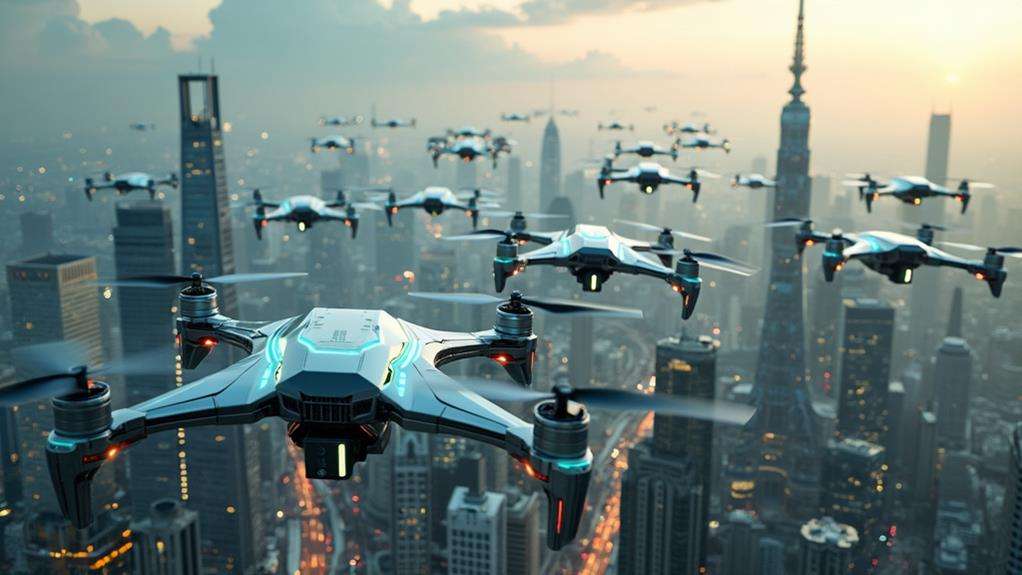
While challenges and concerns are significant, the future of UAV swarming technology holds promising prospects. The global market for drone technology is expected to skyrocket, reaching $447.2 million by 2030, driven by an impressive CAGR of 40.47%. This growth is fueled by advancements in swarm intelligence and artificial intelligence, boosting operational efficiency in both military and civilian sectors.
In military contexts, drone swarms are set to revolutionize intelligence gathering and tactical operations. Enhanced AI integration and advanced communication systems will make these swarms more effective and versatile. Collaborative operations between drone swarms and manned aircraft will likely become more common, showcasing the adaptability of this technology.
Beyond the battlefield, drone swarming technology has immense potential in urban air mobility and disaster response. Fleets of drones could deliver supplies during emergencies or aid in logistics, dramatically improving response times and efficiency.
As nations vie for supremacy in drone capabilities, the strategic importance of these systems will grow, potentially leading to a global arms race. However, the broader impact of drone swarms in civilian applications could transform industries and redefine possibilities in urban environments.
Public Awareness
Public awareness of UAV swarming technology is growing, driven by increased media coverage and notable advancements in the field. As more articles and news segments highlight drone technology, it's clear that the public is beginning to understand its vast potential. A survey among academics shows rising interest, indicating a shift in perception and awareness of swarm applications. However, this awareness isn't uniform across all demographics, underscoring the need for targeted educational programs.
To visualize the impact and necessity of public awareness, consider these scenarios:
- Students learning about drone swarms through interactive classroom modules.
- Community workshops where experts explain the benefits and safety measures of drone technology.
- Media reports showcasing successful drone swarm missions in disaster relief.
- Public forums discussing the ethical considerations and regulations of drone use.
- Online courses designed to educate various age groups on the fundamentals of UAV swarming.
These initiatives can help bridge the awareness gap and ensure a more informed public.


